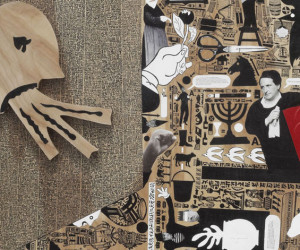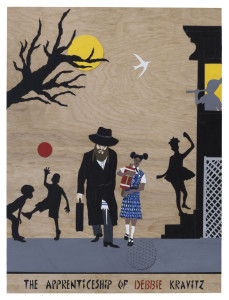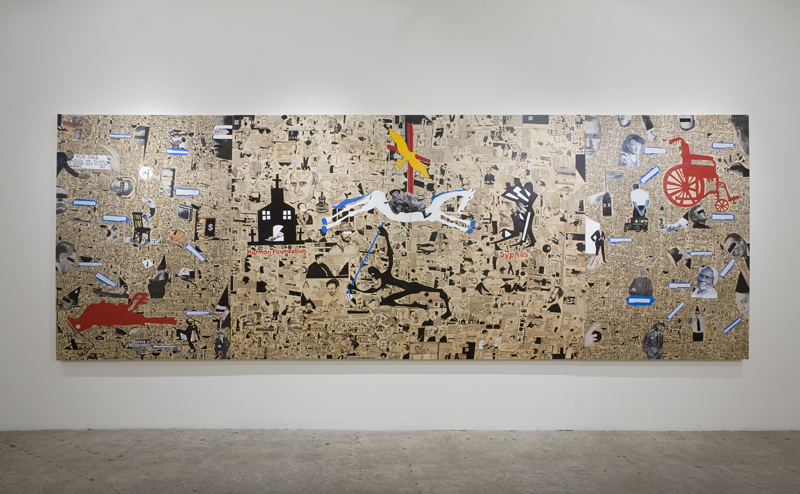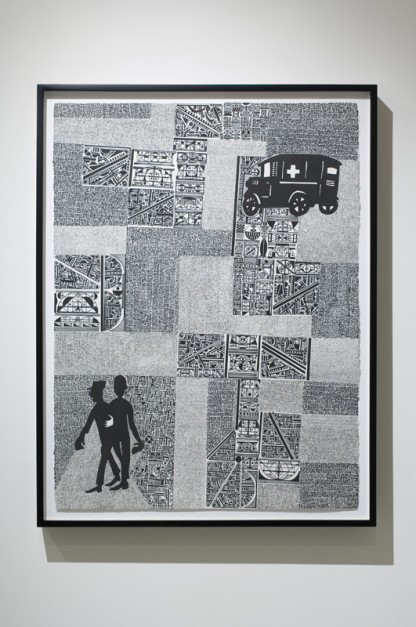
Deborah Grant appropriates from artworks by famous male artists including Picasso, Bacon, Basquiat and Matisse as well as from lesser known artists such as Bill Traylor and William H. Johnson. She then reworks their images to address narratives pertinent to her own life experience and identity while conflating important historical events with current events.
Crowning the Lion and the Lamb, 2013.
Deborah Grant received a BFA at Columbia College, Chicago (1996), an MFA in painting from Tyler School of Art, Philadelphia (1999) and did residencies at the Skowhegan School of Painting and Sculpture (1996); The Studio Museum in Harlem (2002/2003); Headlands Center for the Arts, Sausalito (2004); A.S.A.P Residency in Mount Desert Island, Maine (2005). She has had solo exhibitions at The Drawing Center, New York (2014), Roebling Hall, New York (2006), Dunn and Brown Contemporary
She is represented by: Steve Turner Contemporary
6026 Wilshire Boulevard | Los Angeles California | 90036
T 323 931 3721 | F 323 931 3751 | info@steveturnercontemporary.com
God’s voice in the midnight hours, 2013.
About:
Deborah Grant Plays Matchmaker
Aimee Walleston, Art in America, January 28, 2014
The title of New York-based artist Deborah Grant’s new exhibition at New York’s Drawing Center, “Christ You Know It Ain’t Easy!!,” derives from “The Ballad of John and Yoko,” a 1969 Beatles song about John Lennon and Yoko Ono, a couple of near-mythic status. Grant’s exhibition (through Feb. 28) consists of 32 works in which Grant presents an imagined meeting of another complicated-albeit fictitious-couple: Henri Matisse and a virtually unknown Black American folk artist, Mary A. Bell.
According to the accompanying catalogue for this exhibition, her first New York museum solo, Grant spent two years researching Bell’s life and oeuvre. The wall pieces she created in response, mostly painted birch panels, are part of an ongoing series, “Random Select,” which she began in 1996. Grant is known for analyzing the life and work of other artists, notably Picasso and Bill Traylor. Her work often metabolizes her analysis into stream-of-consciousness pictographic images heavy with symbolism. The “Random Select” series has also featured other meetings of fictitious couples. In 2008, Grant created Suicide Notes to Self, an abstract painting rendered on five birch panels that visually narrated another imagined meeting, this one between Francis Bacon and African-American comedienne Jackie “Moms” Mabley.
Thief in the Night, 2011.
For “Christ You Know It Ain’t Easy!!” Grant has once again translated a fabulist narrative into paintings that focus mostly on the signature imagery of Matisse in relationship to the biography of Bell. In one obsessively detailed, four-panel work, Crowning the Lion and the Lamb (2013), Grant renders both religious and Matissean iconography-including doves, potted plants and palm fronds. The religious motifs tie closely to Bell, a devout Catholic who reportedly developed her drawing practice as a way of honoring God, to whom she attributed all her work. Born in Washington, D.C., in 1873, Bell worked as a maid her whole life. In her spare time, she created crayon and colored pencil drawings depicting finely dressed ladies and gentlemen. According to a 1991 essay published in the Christian Science Monitor by author Stephen May, Bell wrote, of her decision to draw ladies of an upper social class, “Of course it is proper to have a lady in everything, because she is the cream of the earth and I think everyone likes cream.”
More than 100 of Bell’s drawings can be found in Yale’s Beinecke Library, donated by the novelist, photographer and critic Carl Van Vechten, one of Bell’s few collectors. May claims that between 1936 and 1939 Bell created over 150 known works, most of which she sold for 50 cents each to Van Vechten, who met Bell through sculptor Gaston Lachaise (Bell worked as a maid for his sister-in-law). Of her work, Van Vechten wrote, in a letter to Gertrude Stein, “[Bell is] something like [Henri] Rousseau. But O so different. What an artist!”
Both Matisse and Bell produced work that prized a certain ostentatious beauty-the subject of Matisse’s 1905 Woman with a Hat, for example, possesses the same prize-hen grandeur found in Bell’s drawings of fancy ladies. The two artists’ biographical circumstances, however, are diametrically opposed: while Matisse enjoyed a life of privilege, Bell died alone, buried in a pauper’s grave. This opposition, and the identities of the artists themselves, appears to intrigue and compel Grant. In particular, the devout Bell seems to offer Grant, an African-American artist who, according to the exhibition catalogue, was also raised Catholic, a psychic avatar to explore religion. In one panel from the 24-panel God’s Voice in the Midnight Hours (2013), she depicts herself walking hand-in-hand with a rabbi-a memory from her childhood in Coney Island, and a record of her fascination with a rabbi neighbor. In another panel from the same work, she paints a white suit riddled with arrows, with the words “St. Sebastian Venable” underneath, tying the story of the Christian martyr with the murdered anti-hero of Tennessee Williams’s 1958 play Suddenly Last Summer. It’s another intriguing connection from an artist seemingly chock full of them.





